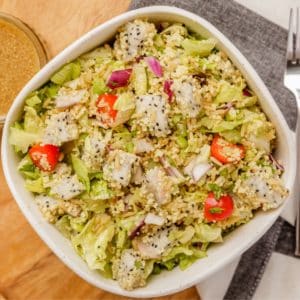The dragon fruit in this couscous salad gives it an unexpected sweet taste.

This salad can be made ahead of time and be ready when you are to enjoy a hearty and flavorful meal. The couscous and wild rice help make this plant-based dish a protein-packed one!

What is Couscous?
Couscous is a traditional food from Northern African cultures and consists of small balls of durum wheat or semolina flour. It is often mistaken for a grain, but it is actually the same dough that is made into many kinds of pasta.
It first appeared in historical records in the 13th century in North African countries and was later reported to be a growing food staple in Middle Eastern countries and Turkey.
What Makes Couscous So Special?
Couscous is generally a healthful food that you can feel comfortable including as part of a plant-based, whole food diet. It's naturally low in fat, can be a good source of fiber (the whole wheat version), and provides protein, B vitamins, and plenty of minerals.

Is Couscous a Superfood?
Couscous is a high nutrition food containing selenium, calcium, phosphorus, potassium, magnesium, folate, thiamin, niacin, folic acid, manganese, and other vitamins and minerals.
It can help keep your blood glucose controlled as well as can keep you feeling fuller longer. It also can help lower cholesterol, which can reduce your chances of heart disease.
Whole-grain couscous is a good source of fiber. Fiber is good for you in a lot of ways. Couscous is a good source of plant-based protein, providing 6 grams per one-cup serving.
The fiber in couscous is also important for digestion. Since it moves food quickly through your intestinal tract, fiber can help prevent constipation. A higher-fiber diet can also lower your odds of intestinal and breast cancers.
Whole wheat couscous can also be a healthier swap for refined white pasta or white rice.

Couscous Buying Tips
Couscous has grown in popularity over the past few years, so you should not have too much trouble finding it in most major supermarkets. The first stop in a grocery store should be in the rice and/or grains aisle—that's where couscous is usually stocked.
If you can't find couscous there, next try the international food section. Some stores group foods from all different world cuisines in the same aisle; sometimes couscous is integrated within other aisles, such as the rice or pasta aisle. It's also available online.
How to Store Couscous
Like other whole-grain foods, uncooked whole-grain couscous can go rancid. If you store it in an airtight container in a cool, dry place, it can last up to 2 months. It’ll last 6 to 12 months in the refrigerator or freezer.
Don’t Forget About the Dragon Fruit
Dragon fruit is a food that grows on a climbing cactus called hylocereus, which you'll find in tropical regions around the world. The plant’s name comes from the Greek word "hyle," which means "woody," and the Latin word "cereus," which means "waxen."
On the outside, the fruit has the appearance of a hot pink or yellow bulb with spike-like green leaves shooting up like flames around it. Cut it open, and you'll find a fleshy white inside dotted with black seeds that are okay to eat.
The cactus originally grew in southern Mexico and South and Central America. The French brought it to Southeast Asia in the early 19th century. Now fruit is easily found in red- and yellow-skinned varieties.
Dragon fruit is high in vitamin C and other antioxidants, which are good for your immune system. It can boost your iron levels. Iron is important for moving oxygen through your body and giving you energy, and dragon fruit has iron. And the vitamin C in dragon fruit helps your body take in and use the iron.
Dragon Fruit Buying Tips
Before you buy dragon fruit, squeeze it gently. It should give a little bit without feeling too soft or mushy. Avoid fruit that has bruises or dry leaves -- signs that it's overripe. If it feels hard when you press on it, let it ripen on the counter for a few days before eating.


Couscous & Dragon Fruit Salad
Ingredients
- 2 cups cooked couscous
- 1/2 medium head of iceberg lettuce - chopped
- 1 medium stalk of celery - finely chopped
- 1/2 small red onion - finely chopped
- 1/4 cup fresh cilantro - finely chopped
- 14 cherry tomatoes - halved
- 1 cup cooked wild rice
- 1 medium dragon fruit - chopped
- 1/4 cup maple syrup
- 1 tbsp Dijon mustard
- 1 lemon's juice
Instructions
- Mix in a large bowl couscous, lettuce, celery, onion, cilantro, tomato, wild rice, and dragon fruit. Toss.
- Whisk the maple syrup, lemon juice, and mustard together and pour over the salad. Mix thoroughly.

